James Maliszewski's Blog, page 66
November 15, 2023
A Mystery Solved?
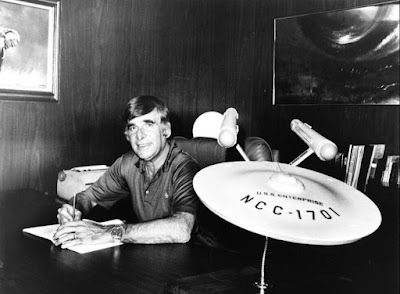 Being a Star Trek fan, I was aware of the fact that, sometime during the early stages of the production of 1979's Star Trek: The Motion Picture, the original 33-inch model of the U.S.S. Enterprise (used in the title sequence of the television show) had become lost. Gene Roddenberry had a sentimental attachment to the model and was keen to get it back, but, despite his best efforts, he was never able to do so. Its disappearance was thus one of big mysteries of Star Trek lore – that is, until the end of last month.
Being a Star Trek fan, I was aware of the fact that, sometime during the early stages of the production of 1979's Star Trek: The Motion Picture, the original 33-inch model of the U.S.S. Enterprise (used in the title sequence of the television show) had become lost. Gene Roddenberry had a sentimental attachment to the model and was keen to get it back, but, despite his best efforts, he was never able to do so. Its disappearance was thus one of big mysteries of Star Trek lore – that is, until the end of last month.According to this article, a listing on eBay for a replica of the Enterprise caught the eyes of some fans, who suspected that it might well have been the model missing for nearly half a century. They contacted the seller with their suspicions, recommending he get in touch with Roddenberry's family about it. Soon thereafter, Roddenberry's son, Rod, issued the following statement:
“Along with much of the Star Trek community, I was excited and pleased to learn that the original 3-foot filming model of the Starship Enterprise appears to have been discovered after being missing for decades (pending full authentication). I can confirm that I am now, through an intermediary, in contact with the individual who possesses the model.
This prototype played a key role in the visualizing design of the famous television starship during Star Trek’s early development in 1964. Once the show went into production, the model was actually filmed in numerous visual effects shots seen throughout the life of the original Star Trek series, along with a larger, 12-foot model that is currently displayed at the Smithsonian National Air and Space Museum. I am convinced that this prototype model holds immense significance for Star Trek and its 58-year history. From its creation in the mid-60s until about 1977, the model was in the possession of my father, Star Trek creator Gene Roddenberry. Unfortunately, it went missing after being loaned out during the production of Star Trek: The Motion Picture.
Beyond its physical value, the greater significance is this prototype Enterprise model really represents the underpinning ideas my father imbued into the series. That we are clever, resilient and can learn from our mistakes. We can and will move beyond archaic belief systems. And once we truly embrace the infinite diversity all around us, both in form and idea, we will then take those next step into a prosperous and unlimited future.
Guided by this principle, one of my primary goals over the past decade has been to locate, recover, and digitally archive significant Star Trek materials and artifacts through the Roddenberry Archive project. The intention would be to scan it in the finest detail for the Roddenberry Archives and after rigorous scrutiny make it available to the public. Furthermore, I firmly believe that a piece of such importance should not be confined to any private collection. This iconic artifact should be enshrined along side the 12-foot shooting model at the Smithsonian’s National Air and Space Museum, where it can serve to help tell the story of television history, the history of space exploration and ultimately, a beacon of hope for the future.”
I'm quite curious to see how this story plays out. Growing up in Maryland, I regularly visited the National Air and Space Museum in Washington, D.C. A highlight of any such trip was seeing the 11-foot studio model of the Enterprise used for exterior shots in the 1960s TV series. Consequently, this story really piqued my interest. I imagine many of my readers will feel the same way.
Polyhedron: Issue #10
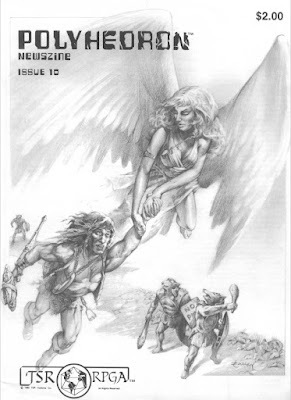 For reasons many and various, I've always had a soft spot for
Gamma World
, which was long one of my favorite roleplaying games, though I have not had the chance to play it at length for some time. Consequently, the Jeff Easley cover illustration to issue #10 of Polyhedron (February 1983) conjures up many fond memories of playing the game. It's also a good way to kick off what editor Mary Kirchoff dubs "the GAMMA WORLD® issue." That probably goes some way toward explaining why this particular issue of the 'zine sticks in my head after all these years.
For reasons many and various, I've always had a soft spot for
Gamma World
, which was long one of my favorite roleplaying games, though I have not had the chance to play it at length for some time. Consequently, the Jeff Easley cover illustration to issue #10 of Polyhedron (February 1983) conjures up many fond memories of playing the game. It's also a good way to kick off what editor Mary Kirchoff dubs "the GAMMA WORLD® issue." That probably goes some way toward explaining why this particular issue of the 'zine sticks in my head after all these years.The issue places its Letters page at the front this time rather than relegating it to the back, as was the case previously. I usually don't mention this feature, because the letters tend to focus on banal and/or ephemeral matters. This time, there's one letter I find intriguing. The writer takes issue with the oft-repeated statement that AD&D is "for adults." The writer explains that he doesn't "know one individual over 30 who enjoys AD&D or D&D®." He adds that he "wish[es] there would be more Dungeon loving Dads and Monster loving Moms." Kirchoff then addresses the "subject of getting adults involved" in roleplaying games. To this, Kirchoff replies:
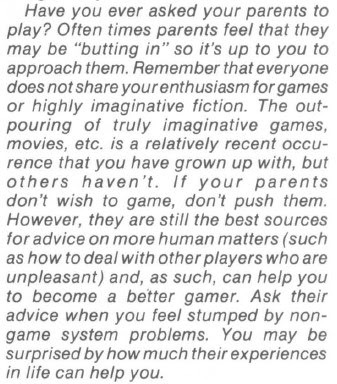 My own early experiences of the hobby involved several adult players, including the father of one of my friends (who was a hex-and-chit wargamer), so it's an odd question for me. In fact, when I first started seriously playing D&D – this would have been early to mid-1980 – the impression I had at the time was that it was primarily an adult pastime, because I initially knew very few kids who played beyond those whom I'd personally introduced to the hobby. That started to change very quickly and, by the time this letter appeared, in early 1983, I suspect the demographics had skewed considerably toward younger players.
My own early experiences of the hobby involved several adult players, including the father of one of my friends (who was a hex-and-chit wargamer), so it's an odd question for me. In fact, when I first started seriously playing D&D – this would have been early to mid-1980 – the impression I had at the time was that it was primarily an adult pastime, because I initially knew very few kids who played beyond those whom I'd personally introduced to the hobby. That started to change very quickly and, by the time this letter appeared, in early 1983, I suspect the demographics had skewed considerably toward younger players.This issue's installment of Ron Shirtz's "The Knight-Error" comic hit home.
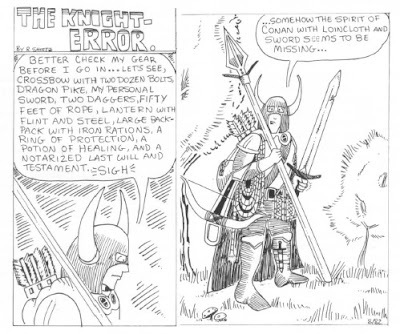 It's a much-needed reminder that, for all its connections to the fantasy literature that preceded it, Dungeons & Dragons doesn't really emulate any of them and is essentially it's own distinct genre.
It's a much-needed reminder that, for all its connections to the fantasy literature that preceded it, Dungeons & Dragons doesn't really emulate any of them and is essentially it's own distinct genre."Tips for the Beginning GM" by Mike Price (author of Famine in Far-Go and co-author of The Cleansing War of Garik Blackhand ) provides the first bit of Gamma World content for the issue. Like most such articles – especially short, one-page ones, like this one – it's advice is mostly very broad and equally applicable to any RPG. The main thing that Price suggests that I think is genuinely useful is his suggestion to photocopy a section of a present-day atlas to establish the locations of landmarks and ruins. Of course, this advice is tempered by the fact that Gamma World's apocalypse occurs centuries from now, making a 20th century map a shaky foundation on which to build a campaign map (but then this is a longstanding problem with the setting of the game).
"Dispel Confusion" presents questions and answers for most of TSR's RPGs from the time: AD&D, Boot Hill, Dawn Patrol, Gamma World, Star Frontiers, and Top Secret. The questions are the usual mix of genuinely unclear matters in the rules and obvious stuff that suggests the questioner has poor reading comprehension. My hat is off to the TSR employees given the job of answering these queries; they had greater patience than I could have mustered. The issue also includes another pun-filled "Reiga Nerd" story entitled "A Mad-Djinn-Airy Tale." I'm not a fan myself, but Gygax loved puns, so who am I to judge?
Frank Mentzer's "Mapping from Square One" is the first part of a three-part series focuses on, well, mapping. The intention behind the series is to win over "map-haters" to the joys – and benefits – of mapping in D&D and other RPGs. This seems a worthy goal, as I've often lamented the way that mapping has slowly declined in importance in D&D over the decades. The first part devotes itself primarily to establishing the basics of how to map, such as tools and terminology. Mentzer also suggests that it's the job of the referee to correct errors on the players' map if they're made due to error or inexperience. I think that's good advice, though it wasn't commonplace during my own early days in the hobby.
James M. Ward's "Encounters" presents a situation for Gamma World, in which a pure strain human is rescued from a band of mutant arks (dog men) by a member of a new mutant species, the flynns. The cover image above depicts the scene quite nicely. Frank Mentzer returns with another installment of "Notes for the Dungeon Master." This time he inveighs against treating the gods as high-level monsters that can be killed by appropriately powerful characters. It's perfectly sensible advice, of course, but it might seem to run counter to the approach of Deities & Demigods , which does include game stats for divine beings (though, to be fair, that book does indicate that no mortal being can slay a god permanently, even if he should somehow defeat one in combat). I remember lots of people back in the day whose campaigns include the defeat of deities by player characters.
"Basically Speaking" by Jon Pickens looks at (among several other topics) the vexed question of how the D&D and AD&D games differ from one another. Pickens claims that the difference lies in their "intended audiences." The gist of his explanation is as follows:
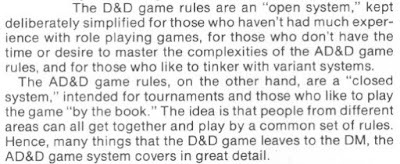 It's an interesting perspective and one I find much more congenial than Gygax's claim that D&D had become a "non-game." Mind you, I am biased: I much prefer the open-ended approach of D&D over the more cramped style of AD&D (even if I still adore many of its distinctive elements).
It's an interesting perspective and one I find much more congenial than Gygax's claim that D&D had become a "non-game." Mind you, I am biased: I much prefer the open-ended approach of D&D over the more cramped style of AD&D (even if I still adore many of its distinctive elements)."Under Construction" is a new column that describes a room or location that can dropped into a referee's campaign. The premier example, by Mary Kirchoff, is a dungeon room cursed by a jealous goddess. The room, which has a rose theme, traps those who enter it unless they can puzzle out the meaning of a rhyme written on the floor. Though perhaps a bit overwritten in its description, the room is clever and very much in keeping with the kinds of chambers I remember in the dungeons of "killer DMs" of my acquaintance.
"Getting Started in Gangbusters Game" by Mark Acres offers up ten short tips for new referees, none of which are really unique to that game. It's filler content of no lasting value, alas. Even so, it's still more interesting than the two pages of "The Official RPGA™ Tournament Scoring System." I know Polyhedron is the RPGA 'zine, but come on! "Flight of Fancy" by Mike Carr is a brief Dawn Patrol scenario involving a zeppelin. Frank Mentzer returns (again) with another "Spelling Bee." His chosen topic is a good one: spell coordination. By this he means only that players of spellcasting characters should confer with one another before selecting spells, so that they might benefit from certain synergies. He provides several examples, which is certainly helpful. The remainder of the issue is devoted to another catalog of RPGA-only items.
Issue #10 is a very solid one and, as I said at the beginning of this post, a particular favorite of mine. I feel like the 'zine is now on much more solid footing, with a wider variety of content. That pleased me when I first received it, because I played multiple TSR games, not just Dungeons & Dragons. Looking back on it now, it pleases me even more.
November 13, 2023
No Longer a Challenge
Here's another interesting passage from the September 1980 issue of Fantastic Films, where its author, Neesa Sweet, talks to Jeff Urquhart, owner of Sutler's Wagon Hobby Shop in Chicago (any readers remember this place?).
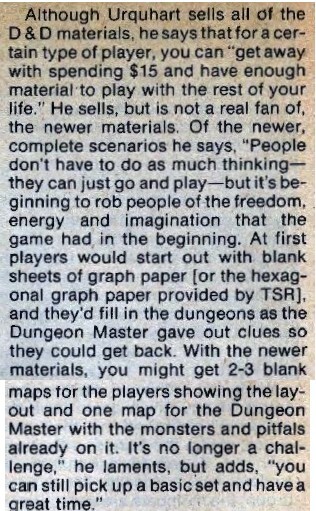 What I find most remarkable about Urquhart's comments is that, even in 1980, it was already apparent that, as a hobby, RPGs don't actually require players to buy all that much to enjoy them. As he says above, you can "get away with spending $15 ($55 in today's devalued currency) and have enough material to play with the rest of your life." Equally remarkable is that Urquhart doesn't think much of "the newer, complete scenarios," believing that they "rob people of the freedom, energy, and imagination that the game had in the beginning."The more things change, the more they stay the same!
What I find most remarkable about Urquhart's comments is that, even in 1980, it was already apparent that, as a hobby, RPGs don't actually require players to buy all that much to enjoy them. As he says above, you can "get away with spending $15 ($55 in today's devalued currency) and have enough material to play with the rest of your life." Equally remarkable is that Urquhart doesn't think much of "the newer, complete scenarios," believing that they "rob people of the freedom, energy, and imagination that the game had in the beginning."The more things change, the more they stay the same!
November 12, 2023
Death by Misadventure
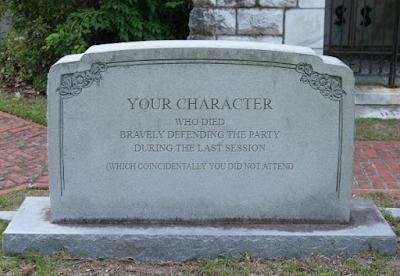 Barrett's Raiders, the Twilight: 2000 campaign I am currently refereeing, is just a little shy of two years old, our first session having been December 6, 2021. Like my House of Worms Empire of the Petal Throne campaign, now in the middle of its ninth year, we play more or less weekly. That's possible in part because there are seven (down from eight originally) regular players, which means that, even accounting for real life interruptions, it's rare that we don't have enough people to play each week.
Barrett's Raiders, the Twilight: 2000 campaign I am currently refereeing, is just a little shy of two years old, our first session having been December 6, 2021. Like my House of Worms Empire of the Petal Throne campaign, now in the middle of its ninth year, we play more or less weekly. That's possible in part because there are seven (down from eight originally) regular players, which means that, even accounting for real life interruptions, it's rare that we don't have enough people to play each week. Sometime toward the end of summer, one of the campaign's stalwarts undertook some new responsibilities that prevented his playing for an extended period of time. Fortunately, there were six other players to pick up the slack and we've soldiered on – pun intended – without him. Nevertheless, his presence is very much missed, both because we enjoy the company of the player and because the character he plays (Sgt. Tom Cody) is an important part of the unit under the command of Lt. Col. J.D. Orlowski.
Indeed, Sgt. Cody is so important to the unit that, even in the absence of his player, he's continued to participate in – and lead – military operations in eastern Poland. Recently, for example, the characters received intelligence suggesting that one or more NATO soldiers were being held captive in Kraśnik, a town not far from their current position. Orlowski tasked a small number of his men, under the command of Cody, to engage in reconnaissance near Kraśnik to determine if the intelligence was accurate and, if so, to assess the difficulty in liberating the NATO captives.
Since Cody's player was still unavailable, one of the other players, whose character was not assigned to the mission, took over playing him for the next few sessions. That's when I joked, "It'll be a shame when [Cody's player] returns and you'll have to tell him that Cody died bravely defending his comrades." We all laughed, because I clearly meant it as a joke. At the same time, combat is Twilight: 2000 can be unpredictable and there was no guarantee that Cody wouldn't die, even if the likelihood was small. Likewise, the player who took him over for those sessions is thoughtful and clearheaded, so he wasn't the sort to do anything too foolish.
The funny thing is that, in my youth, it was not at all an infrequent occurrence for someone's character to die while they weren't present – and it was rarely funny. In those days, we played RPGs a lot and there was an unspoken pact that we'd always be in attendance for every session of every game. To not be there, even for a perfectly legitimate reason, was seen as a rejection of the game or campaign being played, an acknowledgement that it just didn't matter all that much. What can I say? We were young and, as adolescent boys often are, prone to finding any excuse to haze one another.
One of the forms such hazing would take is killing off someone's character when they didn't show up for a game. "Sorry, dude, your fighter died last night, but, don't worry: he died covering our escape from a horde of ghouls." That sort of thing. Of course, as we played D&D in those days, there were innumerable ways to return a dead character to life and we rarely hesitated to make use of them. I think that was a big part of why no one ever hesitated to kill the characters of absent players – we all understood that death wasn't permanent. Thus, the proper response to learning that your character died while you were visiting your grandparents or on vacation at Disney World was not whine and moan, but rather "Oh yeah? That's cool. Have you raised him yet or is that our next adventure?"
While I don't advocate for the killing off of absent players' characters, let alone allow it in games I referee, I still make jokes about it. I wonder why that is? I suppose it's that, as puerile as it was, it was part of my earliest memories of roleplaying games. Those were days of wild-eyed, reckless adventure, when we first began to understand that RPGs gave us the ability to "do" anything we wanted – and a lot of what we wanted was foolish and occasionally cruel. We grew out of that initial childishness in time, but I almost feel as if it were a necessary stage in our development as roleplayers. To become more "serious" as gamers, we first had to indulge our unbridled ids a bit.
Maybe I'm wrong and this isn't a phase that everyone goes through when they're first introduced to this amazing hobby. All I know is that my friends and I did more than four decades ago and, try as I might, I can't say it wasn't fun, after a fashion. Good thing I outgrew it, eh?
November 9, 2023
Inimical and Beneficial and the Worst and the Best
Some fascinating thoughts from Gary Gygax about the role of the Dungeon Master in Dungeons & Dragons (from the September 1980 issue of Fantastic Films). What he has to say reminds me a bit of my defense of the "killer DM" last year.

The Eshkom District
Though progress continues to be quite a bit slower than I'd like – due, in large part, to my constant tinkering – Secrets of sha-Arthan continues to chug along. I've taken a break from working on its rules to working on its setting. In particular, I've been developing a border region of the Empire of Inba Iro that can serve as a starting area for a new campaign. The first step in doing so was producing a map. Here's a scan of a portion of my original, hand-drawn map.
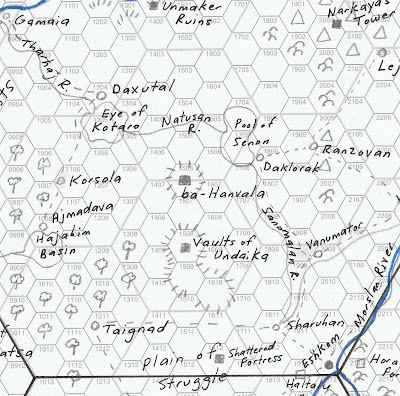 The region is called the Eshkom District, after its largest settlement, the city-state of Eshkom, one of the so-called Twenty Cities of Inba Iro, whose kings swear fealty to the King-Emperor of da-Imer. Eshkom has a history of unrest and periodic rebellion against the Solar Throne, all the more so since Chomachto invaders from the north seized it and declared themselves the new ruling elite of the Empire. I think a troubled border region like the Eshkom District had a lot of potential for adventure.
The region is called the Eshkom District, after its largest settlement, the city-state of Eshkom, one of the so-called Twenty Cities of Inba Iro, whose kings swear fealty to the King-Emperor of da-Imer. Eshkom has a history of unrest and periodic rebellion against the Solar Throne, all the more so since Chomachto invaders from the north seized it and declared themselves the new ruling elite of the Empire. I think a troubled border region like the Eshkom District had a lot of potential for adventure.Fond as I am of hand-drawn maps, I nevertheless wanted something a bit more polished for eventual inclusion in Secrets of sha-Arthan, whatever form it eventually takes (that's a topic for another day). To that end, I turned to the cartographic skills of Glynn Seal of Monkeyblood Design to create a more attractive map. Here's the same portion pictured above in more professional form:
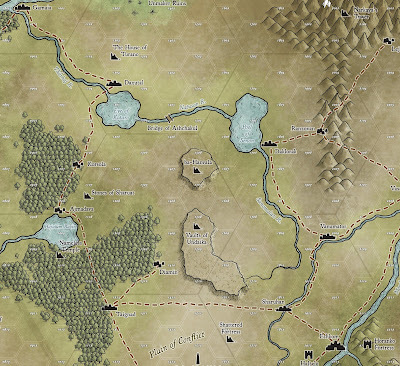 I'm quite pleased with the results. Glynn did a superb job of translating my rough original into something that's both usable and appealing. What I particularly like about Glynn's map is the way that the various settlements and ruins stand out against the background. That's important to me, because I made an effort to include lots of places for the referee to develop into adventure locales and I want their locations to be visually apparent.
I'm quite pleased with the results. Glynn did a superb job of translating my rough original into something that's both usable and appealing. What I particularly like about Glynn's map is the way that the various settlements and ruins stand out against the background. That's important to me, because I made an effort to include lots of places for the referee to develop into adventure locales and I want their locations to be visually apparent.
November 8, 2023
"No, real life is quite horrible."
#OnThisDay 1983: BBC South East at Six explored the magical world of Dungeons & Dragons, with the help of Games Workshop founders Steve Jackson and Ian Livingstone. pic.twitter.com/dxuhI5k2pe
— BBC Archive (@BBCArchive) October 6, 2023
Retrospective: Bugs in the System
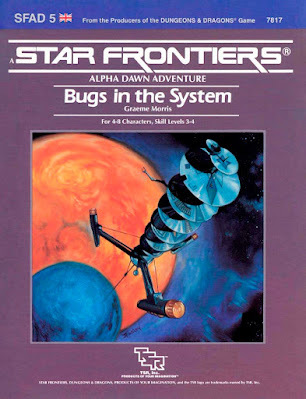 With all the talk of Star Frontiers in issue #9 of Polyhedron, I thought it might be worthwhile to look more closely at what might well be the best adventure ever published for that roleplaying game, Bugs in the System. Some of you may recall that, almost two years ago, I included Graeme Morris's 1985 effort in the list of My Top 9 non-D&D Adventures of All Time. While I still very much stand by that assessment, the module is not perfect – few things are – and I feel that a fuller examination of it lends itself to some interesting topics, both about the history of the hobby and the design of published adventure scenarios.
With all the talk of Star Frontiers in issue #9 of Polyhedron, I thought it might be worthwhile to look more closely at what might well be the best adventure ever published for that roleplaying game, Bugs in the System. Some of you may recall that, almost two years ago, I included Graeme Morris's 1985 effort in the list of My Top 9 non-D&D Adventures of All Time. While I still very much stand by that assessment, the module is not perfect – few things are – and I feel that a fuller examination of it lends itself to some interesting topics, both about the history of the hobby and the design of published adventure scenarios.Bugs in the System is a product of TSR UK, the British division of TSR Hobbies, which closed its doors in 1986. During its brief existence, TSR UK distinguished itself by producing a number of well-regarded and highly imaginative game materials, some of which have long been among my favorites. Though I'm not quite certain I can put my finger on precisely what sets them apart from their American counterparts, there's no denying that there's something unique about even the worst of them.
That's certainly true of Bugs in the System. Whereas the American Star Frontiers adventures, like the Volturnus Trilogy, draw their inspiration from the pulp sci-fi of the genre's Golden Age, Bugs in the System is a fair bit harder edged and "serious" in its approach to science fiction. By "serious," I mean only that Morris takes seriously Isaac Asimov's belief that science fiction isn't really science fiction if it lacks science. Most of what we reflexively call science fiction, especially in the realm of roleplaying games, doesn't include much in the way of genuine scientific speculation. It's mostly fantasy in space, which is absolutely fine in my opinion, but I still appreciate it when an author puts serious effort into incorporating science and scientific ideas into his story.
Bugs in the System does just that and in a way that puts the lie to the notion that "real" science fiction can't still be adventuresome. The premise of the adventure is quite simple: the characters are tasked with the job of traveling to a biochemical extraction platform located in the upper atmosphere of a gas giant to determine the nature a disaster that cut it off from contact and, if possible, effect repairs and rescue any surviving members of its crew. It's a classic set-up for an adventure, since it provides the characters with just enough information to understand their ostensible mission and leaves just enough unknown that there's no doubt in the players' minds about the fact that unraveling a mystery is why their characters are truly traveling to the extraction platform.
As I noted, Morris is very committed to the adventure's scientific speculation. The nature of the disaster that struck the extraction platform is an unintelligent, microscopic organism that consists of patterns of electrical impulses. These patterns gather together simple compounds from the atmosphere of the gas giant to build up large biochemical molecules in which they "live." A mutated form of this lifeform has infected the extraction platform's circuitry, causing malfunctions and other anomalies – in short, a living computer virus. That may not seem like an original idea in 2023, but, nearly four decades ago, it was and I remember thinking how clever Morris was to have come up with it.
Of course, the fun of the adventure isn't simply in the high concept of its backstory. The fun comes from the characters wandering around the extraction platform, which is supported by bags of gas heated by nuclear reactors, looking for clues to what might have happened, as well as dealing with the malfunctions caused by the lifeform. Characters with technological skills, particularly computers and robotics, will have a lot to do. Morris put a lot of thought into how the lifeform operates within the computer systems and how the characters can combat it. There are even charts and diagrams, depicting the architecture of the platform's mainframe, programs, and terminals, intended both to visually represent the overall system but also to aid the characters as they attempt to track down and isolate the lifeform.
Overall, Bugs in the System is a thoughtful and challenging scenario, one that rewards characters who pay attention and carefully consider evidence. Even so, that strength is also something of a weakness, in that characters – and players – who are not as scientifically/technologically inclined might become a bit bored. Morris seems to recognize this, hence the inclusion of malfunctioning robots to fight, including one whose outward appearance hides its true nature (shades of Ash in Alien). I can't really fault him for this, since he needs to ensure the module holds appeal for a wider audience, but I found these obligatory combat-oriented threats somewhat jarring even at the time. They only appear more so today.
As I stated at the beginning of this post, I stand by my judgment that Bugs in the System is one of my favorite RPG adventures of all time. Its underlying idea is very solid and its implementation excellent. Graeme Morris put a lot of thought into it and it shows. The maps and diagrams (by Paul Ruiz) are clear and well-done, too, which only adds to the module's overall quality. It's just a pity that, likely as a concession to those who prefer their "science fiction" to be Star Wars rather than 2001, there are all these unnecessary shoot 'em ups sprinkled throughout. Them's the breaks, I guess.
November 7, 2023
A World of Swords & Sorcery Awaits You
From issue #81 (September/October 1977) of Don Greenwood's Campaign magazine (formerly Panzerfaust):

Polyhedron: Issue #9
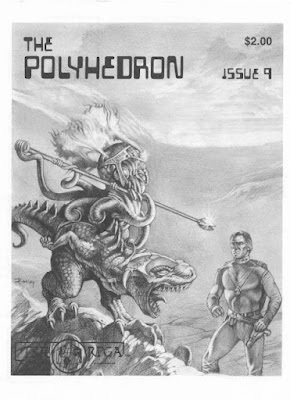 Issue #9 of Polyhedron (December 1982) features a piece of
Star Frontiers
-inspired cover art by Jeff Easley. That makes sense, since this issue features a pair of Star Frontiers articles, no doubt intended to introduce the 'zine's readers to TSR's then-new science fiction RPG. Issue #9 is also notable for being 32 pages in length, twice that of issue #8. While that sounds good in principle, the amount of gaming material is not noticeably greater in my opinion. Much of the additional page count is given over to advertising for the RPGA and its products. That make sense, I suppose, given the actual purpose of Polyhedron, but I always looked on the fanzine as a "Dragon Jr" and so was disappointed by how much of it was devoted to strictly RPGA matters.
Issue #9 of Polyhedron (December 1982) features a piece of
Star Frontiers
-inspired cover art by Jeff Easley. That makes sense, since this issue features a pair of Star Frontiers articles, no doubt intended to introduce the 'zine's readers to TSR's then-new science fiction RPG. Issue #9 is also notable for being 32 pages in length, twice that of issue #8. While that sounds good in principle, the amount of gaming material is not noticeably greater in my opinion. Much of the additional page count is given over to advertising for the RPGA and its products. That make sense, I suppose, given the actual purpose of Polyhedron, but I always looked on the fanzine as a "Dragon Jr" and so was disappointed by how much of it was devoted to strictly RPGA matters.Editor Mary Kirchoff's "ESP" column not only crows about the increased bulk of Polyhedron, but also suggests in passing that, by this point, the RPGA had about 5000 dues-paying members. She then introduces Gary Gygax's "Holiday Greetings!" column, which is accompanied by this somewhat frightful image, drawn by Jim Holloway:
 Though I know it's meant in fun, I nevertheless can't help but wince a little bit. As I've mentioned many times on this blog before, TSR spent many years promoting Gary Gygax as the company's version of Stan Lee – an avuncular, slightly cranky authority figure to serve as its public face. No doubt it worked well for TSR fanboys like myself, but I cannot help but wonder if led to problems elsewhere (not the least of which being the feeding of Gygax's ego). In any case, Gygax's column doesn't hold much of lasting interest; it's mostly a rundown on the growth and future of the RPGA.
Though I know it's meant in fun, I nevertheless can't help but wince a little bit. As I've mentioned many times on this blog before, TSR spent many years promoting Gary Gygax as the company's version of Stan Lee – an avuncular, slightly cranky authority figure to serve as its public face. No doubt it worked well for TSR fanboys like myself, but I cannot help but wonder if led to problems elsewhere (not the least of which being the feeding of Gygax's ego). In any case, Gygax's column doesn't hold much of lasting interest; it's mostly a rundown on the growth and future of the RPGA.More interesting is Mary Kirchoff's second article, "Confessions of a Greenhorn Gamer." In it, she admits to a "deep, dark secret" about herself, namely that she is "not yet a 'gamer.'" She further admits that, when she was hired for her position as editor, she hadn't played any roleplaying games. Though she's rectified this during her time at TSR, she is "still not among the masses who can quote the DMG." With that confession out of the way, she shares her initial impressions of roleplaying, focusing on her time playing a fighter/cleric named Derrick in a confusing session that resulted in Derrick's death at the hands of another party member. From Kirchoff's brief description, it doesn't seem as if the established players made much of an effort to ease her into the game – not surprising: that was the style at the time – but she somehow came to enjoy the experience anyway. Truth be told, this is one of the more interesting articles in the issue and probably worth examining at greater length, if only for the Jim Holloway illustration that accompanies it:
 Next up, Steve Winter "reviews" Star Frontiers. I put reviews in scare quotes, because it's not really a critical look at TSR's new SF RPG so much as an advertisement for it. The most interesting part of the piece is that, since its release in August, Star Frontiers had sold 49,500 copies. Winter compares this favorably to FGU's Space Opera, released in 1980, which had sold only 20,000 copies. On the other hand, GDW's Traveller, released in 1977, had sold over 250,000 copies. I can't speak to the veracity of these numbers, but, if correct, they're very instructive about the relative popularity of the three big science fiction RPGs of my youth.
Next up, Steve Winter "reviews" Star Frontiers. I put reviews in scare quotes, because it's not really a critical look at TSR's new SF RPG so much as an advertisement for it. The most interesting part of the piece is that, since its release in August, Star Frontiers had sold 49,500 copies. Winter compares this favorably to FGU's Space Opera, released in 1980, which had sold only 20,000 copies. On the other hand, GDW's Traveller, released in 1977, had sold over 250,000 copies. I can't speak to the veracity of these numbers, but, if correct, they're very instructive about the relative popularity of the three big science fiction RPGs of my youth.There's a "Christmas Crossword" reprinted from the first issue of the Grenadier Bulletin, along with reprints (also from the Bulletin) of two pun-filled Reiga Nerd tales by Kim Eastland. This month's "Encounters" article is written by David Cook and features a meeting between a human "xenopologist" and a member of the octopus-like Ul-Mor species from Star Frontiers. It's a bit underwhelming, to be honest, and I'm honestly not sure how useful it'd be to anyone actually playing the game. Potentially greater value is to be found in "Dispel Confusion," which offers answers to AD&D, Top Secret, and Gamma World questions sent in by readers.
The winners of the Top Secret gadget contest announced in issue #3 appear in this issue. There are nine winning gadgets, none of which struck me as being anything we've haven't all seen before in one form or another in spy novels and movies. To my mind, the most noteworthy thing about the winners is that one of them, Matt Forbeck, would later go on to become a professional game designer, working on Dungeons & Dragons, among many other games. The winners of the Gamma World art contest, also announced in issue #3, are mentioned too, but the artwork does not appear. I wonder why.
Mike Carr pens a very airy – no pun intended – reflection on Dawn Patrol, which is even less substantial than Steve Winter's review of Star Frontiers. As I said at the beginning of this post, Polyhedron may have expanded its page count, but very little of it was devoted to "game-y" content. That said, Frank Mentzer's "Spelling Bee" looks at the similarities and differences between the polymorph self, polymorph other, and shape change spells in AD&D. This is helpful to both players and referees, though it seems clear Mentzer's intended audience is primarily the latter, since he devotes much of his commentary on the ways to "control" use of the spell, which is to say, rein it in against abuse.
Continuing with the issue's Christmas theme, there are six RPG-themed carols presented here: The Great Druid's Coming to Town, Silver Shells (for Gamma World), O Purple Worm, Jingle Bells, White Dragons, and The Twelve Days of Christmas Gaming. There's also a Christmas-flavored installment of Harry Quinn's "The Knight-Error" comic. "Gen Con XV: Megacon" is a report on the major events of that convention, complete with photographs. Frank Mentzer's "Notes for the Dungeon Master" is the usual grab bag of ideas and advice. However, it also states that "Gary doesn't run a straight AD&D campaign; he's too creative to feel comfortable in that rigid system." He quickly follows this up with, "You say you are, too? How many games, modules, and articles have you written lately?" It's a very odd response in my opinion, suggesting that only the most imaginative, creative, and lofty of people should be free from using the game as written. This kind of attitude is precisely why many gamers were becoming turned off by AD&D at the time.
Aside from the letters page and "Notes from HQ," dealing with RPGA ephemera, all that remains of the issue is the aforementioned catalog of products for sale. All in all, issue #9, despite its size, doesn't really show off Polyhedron to its fullest. Certainly, it's not one of the issue I most remember from my youth. Fortunately, there are – eventually – better ones on the horizon.
James Maliszewski's Blog
- James Maliszewski's profile
- 3 followers



